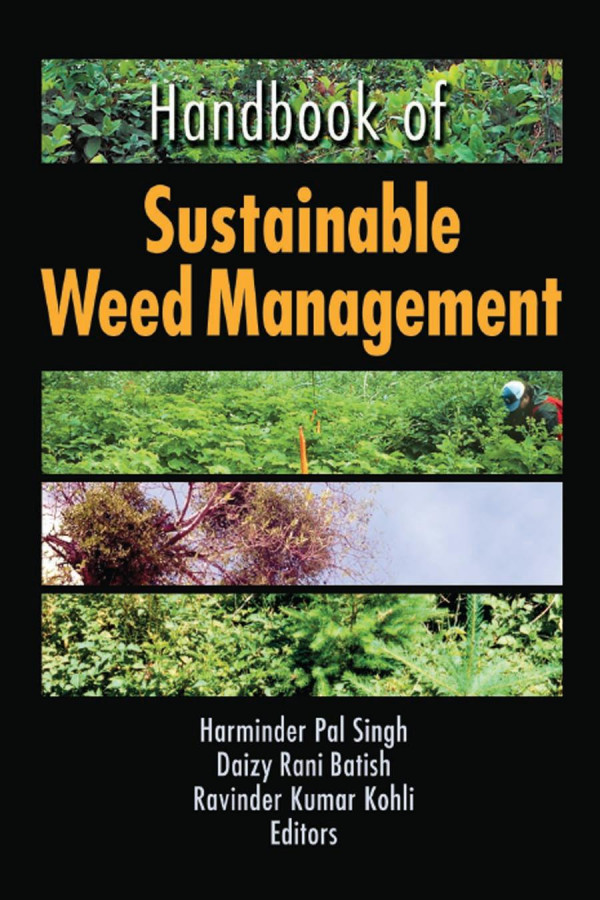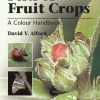Handbook of Sustainable Weed Management 1st Edition by Harinder Singh, Daizy Rani Batish, Ravinder Kumar Kohli ISBN 9781482293593 1482293595
$50.00 Original price was: $50.00.$35.00Current price is: $35.00.
Handbook of Sustainable Weed Management 1st Edition by Harinder Singh, Daizy Rani Batish, Ravinder Kumar Kohli – Ebook PDF Instant Download/Delivery: 9781482293593 ,1482293595
Full download Handbook of Sustainable Weed Management 1st Edition after payment
Product details:
ISBN 10: 1482293595
ISBN 13: 9781482293593
Author: Harinder Singh, Daizy Rani Batish, Ravinder Kumar Kohli
Handbook of Sustainable Weed Management 1st Edition Table of contents:
Chapter 1: Weeds and Their Management: Rationale and Approaches
What Are Weeds?
Why Are Weeds Successful?
Impact of Weeds
Weed Management
Integrated Weed Management
Herbicide-Resistant Crops: Benefits and Harms
Herbicide Antidotes and Synergists
Weed Management—Some Alternate Approaches
Future Directions
Chapter 2: Weed Management: A Basic Component of Modern Crop Production
Introduction
Integrated Pest Management
Components of Integrated Weed Management
Control Strategies
Economic Areas Affected by Weeds and Their Management
Suggestions for Improved Weed Research Management
Chapter 3: Contributions to Weed Suppression from Cover Crops
Introduction
Management Issues
Evidence for Weed Suppression
Weed Suppression Mechanisms
Economics
Conclusions
Chapter 4: Utilizing Brassica Cover Crops for Weed Suppression in Annual Cropping Systems
Introduction
Mechanisms of Weed Suppression with Brassica Cover Crops
Integrating Brassica Cover Crops into Cropping Systems
Conclusions
Chapter 5: Grass-Legume Mixed Cover Crops for Weed Management
Introduction
Benefits of Mixed Cover Crops
Management of a Mixed Cover Crop
Efficacy of Mixed Cover Crop for Weed Control
Crop Yield Following Mixed Cover Crops
Conclusions
Chapter 6: Rye As a Weed Management Tool in Vegetable Cropping Systems
Introduction
The Advantages of Rye Cover Crops
The Disadvantages of Rye Cover Crops
Effects of Rye Cover Crops on Weed Populations
Managing Rye Cover Crops
Mechanisms Explaining Rye Effects on Weeds
The Effects of Weed Control and Rye on Vegetables
Methods to Make Rye a Feasible Weed Management Tactic
Conclusions and Recommendations
Chapter 7: A Rotation Design That Aids Annual Weed Management in a Semiarid Region
Crop Production in the Great Plains of the United States
Impact of Rotation Design on Weed Dynamics
A Rotation Design That Aids Weed Management
Cultural Practices That Improve Crop Competitiveness
Ecologically Based Weed Management in the Semiarid Great Plains
Chapter 8: Examining Tillage and Crop Rotation Effects on Weed Populations in the Canadian Prairies
Introduction
Multisite Project
Weed Community Associations
Conclusions
Chapter 9: Potential of Allelopathy and Allelochemicals for Weed Management
Introduction
Allelopathy, Allelochemicals: A Brief Background
Allelopathic Interactions and Their Scope for Weed Management in Agroecosystems
Cultural Practices, Allelopathic Crops, and Weed Management
Screening of Cultivars with Greater Allelopathic Potential and Their Role in Crop Improvement
Allelochemicals As Herbicides
Potential of Allelopathic Interactions for Parasitic Weed Management
Allelopathy and Management of Aquatic Weeds
Conclusions
Chapter 10: Progress in Developing Weed-Suppressive Rice Cultivars for the Southern United States
Rice in the United States
The Concept of Weed-Suppressive Rice
Optimum Period for Maximum Weed Suppression
Dynamics of Rice-Echinochloa Interference
Red Rice
Integrating Suppressive Cultivars with Reduced Herbicide Rates in Arkansas
Rice Genetics and Crossing Considerations
Rice Breeding Efforts in Arkansas and Some Potential Screening Methods
Induced Mutation: An Alternative to Traditional Breeding Methods
Quantitative Trait Loci and Marker-Assisted Selection As Breeding Tools
Future Prospects
Chapter 11: The Ecology of Weed Seed Predation in Herbaceous Crop Systems
Introduction
Overview of Key Concepts
Weed Seed Predation in Herbaceous Crop Systems
Impact of Seed Predation on Weed Population and Community Dynamics
Herbaceous Crop Fields, Noncrop Habitats, and Weed Seed Predation
How Can We Conserve Seed Predators in Agroecosystems?
Conclusions and Directions for Future Studies
Chapter 12: Mowing for Weed Management
Introduction
Reporting Mowing Practices in Weed Science
Mower Equipment
Preconditions for Mowing
Goals of Mowing in Different Farming Systems
Integrated Weed Management Systems Including Mowing in Combination with Other Weed Management Method
What Scientific Knowledge Is Needed to Better Use Mowing to Achieve Several Goals at Once?
Justifications for Using Mowing in Integrated Weed Management
Chapter 13: Herbicide Fate Under Conservation Tillage, Cover Crop, and Edge-of-Field Management Prac
Introduction of Different Residue Management Systems
Effects of Conservation Management Practices on Organic Matter, Microbiological Characteristics, and
Herbicide Sorption and Movement in Conservation- Managed Systems
Herbicide Degradation in Conservation-Managed Systems
Herbicide Retention and Degradation in Plant Residues
Conservation Edge-of-Field Practices and Herbicide Dissipation
Chapter 14: Strategies for Developing Bioherbicides for Sustainable Weed Management
Introduction
Selection of Biological Control Strategy
Formulations and Spray Application
Integration in Weed Management and Crop Production Systems
Conclusions
Nomenclature
Chapter 15: Developing Microbial Weed Control Products: Commercial, Biological, and Technological Co
Introduction
Commercial Considerations
Biological Considerations
Technological Considerations
Conclusions
Chapter 16: Implementation of Weed Biocontrol in Forest Vegetation Management for Conifer Production
Introduction
Nature of Competing Forest Vegetation: “Forest Weeds”
Methodology Used for Development of Fungal Plant Pathogens As Mycoherbicides for Forest Weeds
History and Current Status of Research and Development of Mycoherbicides for Management of Forest We
Development and Commercialization of Mycoherbicide Products for Use in Forestry
Constraints in the Development of Mycoherbicides for Management of Forest Weeds
Conclusions and General Prospects
Chapter 17: Characterization of Phytotoxins from Phytopathogenic Fungi and Their Potential Use As He
Introduction
Some Phytotoxins from Weed Pathogenic Fungi
Ascochyta caulina Phytotoxins
Chapter 18: Applications of Soil and Rhizosphere Microorganisms in Sustainable Weed Management
Introduction
Deleterious Rhizobacteria
DRB in Integrated Weed Management
Soil and Rhizosphere Bacteria in Sustainable Agriculture
Conclusion
Chapter 19: Herbicide-Resistant Crops and Weed Management
Introduction
Herbicide-Resistant Crops and Their Adoption
Impact of HRCS on Weed Management
Benefits and Risks of HRCS As Weed Management Tools
Conclusions
Chapter 20: Strategies for Managing Herbicide-Resistant Weeds
Introduction
Herbicide Strategies
Nonherbicide Strategies
Integrating Herbicide and Nonherbicide Strategies: Case Studies
Conclusion
Chapter 21: Recent Advances in Parasitic Weed Research: An Overview
Parasitic Species: An Introduction
Orobanche Species (Broomrapes)
Cuscuta Species (Dodders)
Viscum Species (Mistletoes)
Loranthus Species (Mistletoes)
Osyris Species
Cistanche Species
Cynomorium Species
Conclusions
Chapter 22: Management of Weeds in Pasture Systems
Introduction
Impact of Pasture Weeds
Why Are There Weeds in Pastures?
Strategies for Control
Integrated Management of Pasture Weeds
Conclusions
Chapter 23: Integrated Turfgrass Weed Management
Introduction
Identification and Threshold Levels
Cultural Methods
Mechanical Methods
Biological Methods
Chemical Methods
Conclusions
Chapter 24: Approaches to Integrated Weed Management
Introduction
Weed Management
Weed Control Science and Principles of Weed Population Dynamics
Approaches to Developing Integrated Weed Management Systems
Conclusion
Chapter 25: Learning Groups for Implementation of Integrated Weed Management: Principles and Practic
Introduction
Approaches for Developing Site-Specific IWM
A Conceptual Model of Coordinated Innovation in Support of IWM Implementation
Results from Experimental IWM Learning Groups
Recommendations for Professional Roles and Practices in IWM Learning Groups
Conclusions
Index
People also search for Handbook of Sustainable Weed Management 1st Edition:
weed management handbook
sustainable weed management
weed the user’s guide pdf
handbook on weed identification
Tags:
Harinder Singh,Daizy Rani Batish,Ravinder Kumar Kohli,Sustainable Weed Management



